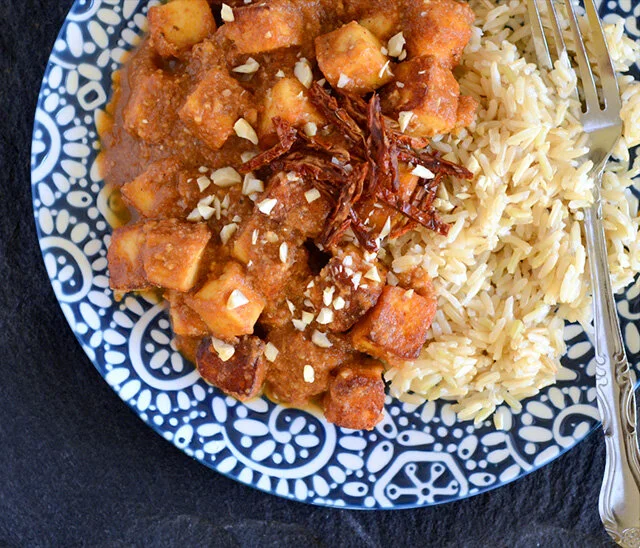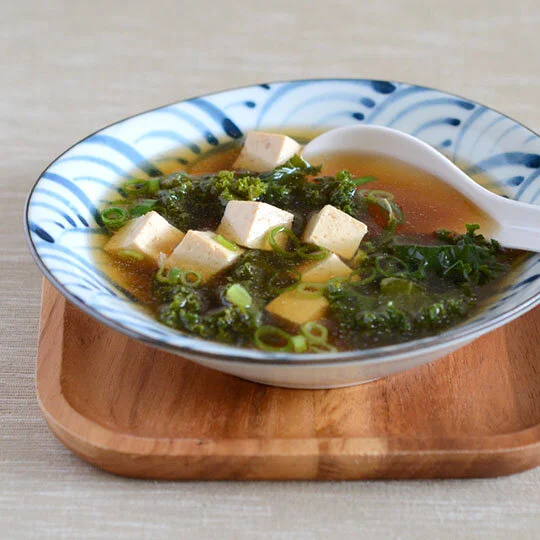Mapo tofu ramen is a hybrid dish that has become a big part of Japan’s ramen culture.
Read MoreI've been trying to pack in as much cooking with tomatoes as I can before the official end of summer.
Read MoreIf I had to make a list of my top favorite comfort foods of all time, mapo tofu would be among the top 10.
Read MoreWhat are some of your favorite quick meals to make when you're under the weather?
Read MoreRed lentil and tofu curry has been one of my staple quick lunches since I was living in Beijing. Ren lentils aren't a common item in China, but I had found a package of organic lentils one day at a supermarket and decided to revive the oh-so-delicious dish that sustained me during my days as a penniless student.
For the past few years, I've made a big pot at least once a month. The firm pan-fried tofu mixed with the meltingly-tender lentils makes this the ideal dish for chilly weather.
Red lentils, despite the name, are actually pinkish-orange in color. They differ from green lentils in that they cook much quicker and become so soft they fall apart. The creamier consistency makes them perfect for curries. After some quick Googling I found a vegetarian recipe easy enough to fit into a hectic day.
If you only have 30 to 40 minutes or so to make a curry for lunch, this is a good bet. For a thicker consistency, use about 4 cups water instead of 5. I like to use cumin seeds because I can toast them and make a much more fragrant dish; however, if you don't like whole spices in your food you can always substitute ground cumin. I love eating this over rice, but you can also try dipping it with pita or crusty French or Italian bread.
Read MoreEvery once in a while I get a huge craving for General Tso's chicken but want a slightly lighter option. Recently I've also gotten a few emails from readers who were curious about how to make vegetarian versions of their favorite takeout dishes. So I got inspired to do a vegetarian General Tso's using tofu.
One of the benefits of using tofu is that it's quicker and a bit easier than preparing the chicken. Instead of shallow-frying the chicken, you just pan-fry the tofu cubes in a large skillet with a couple tablespoons of oil to get it nice and crispy on the outside. And you don't even have to worry about searing all the sides. Just use a spatula to get about 1/2 or 3/4 of the sides to a nice golden color; this way, the tofu is crisp on the outside but still soft on the inside.
For this recipe, I adjusted the quantity of the sauce that I usually use for General Tso's chicken, and a couple of ingredients in it, to compensate for the protein not being marinated. A few readers have noted in the comments of General Tso's chicken that they used ketchup instead of tomato paste with great results, so I added it as a substitute; it's great if you prefer a sweeter sauce in your General Tso's.
Read More
I'm going to come clean about a recent addiction.
Don't worry, it's not drugs or smoking or cheap vodka. But my doctor still might not approve. You see, a few months ago I discovered my local co-op got fresh almond croissants delivered everyday from Cannelle Patisserie, easily one of the best pastry shops in New York. They are big and filled with almond paste and flakey in the best way possible. I can't get enough of them.
On a good week, I'd get one or two for breakfast and be done with it. During weaker periods, I'd succomb to three or four in a week. Self control, at least when it comes to croissants, is not my strongest quality.
In an effort to prevent my diet from being way too carb-heavy, I've been experimenting with some healthy lunches that aren't rice- or noodle-based. Or rather, wheat-noodle-based. I still like the thought of having noodles, so why not just make them out of vegetables instead?
Read MoreIn the dead of summer in Sichuan province, folks regularly eat incredibly spicy, stomach-burning hot pot with the belief that sweating profusely will cool you off. It makes sense, then, that some of the world's spiciest cuisines (Mexican, Indian, Malaysian, etc.) hail from the hottest climates.
I cook and eat spicy food year-round, even if I have to pour myself an enormous iced drink and blast the fan to enjoy it. My latest dish from two nights ago is a simple but very addictive Sweet Chili-Glazed Tofu. If you're a fan of mapo tofu, like 99.5% of people who have ever eaten Sichuan food, this is another good tofu recipe to try. More tongue-tickling spicy than ma la, with a sweet kick and subtle fruity aroma from cider vinegar, this quickish stir-fry makes an easy one-bowl dinner. With lettuce wraps instead of rice, it also becomes a good backyard cookout appetizer.
Read MoreThis afternoon, less than 24 hours before hopping on a train to Hong Kong, I was faced with a dilemma. Do I boil some instant ramen noodles and start packing early, to ensure I remember everything and not wait until the last minute? Or do I make myself a good, hearty lunch, while updating my iPod with all the new music and podcasts necessary for a long train ride?
A perpetual procrastinator, I chose the latter.
The plan was to make Kung Pao Chicken (Gongbao Jiding), because that was what I was craving. Then I looked in the fridge and saw a pack of lonely-looking tofu, which would certainly go uneaten before the trip.
Read MoreRemember when I wrote about the kaleidoscope of tofu available in China? Here's a couple I picked up today at the market:
The lighter colored pack is 豆干 (dòu gān), the super firm kind I like to use in dishes like caramelized tofu. The other was new to me, and intrigued me because the name on the packaging: 啤酒肉片 (píjiǔ ròupiàn) literally reads as "Beer Meat Slices." I know the character for "meat" in Chinese can also mean the flesh of any food, from pigs to pineapples to tofu. But the "beer" part I couldn't figure out, since it wasn't listed as one of the ingredients.
Nor did it taste much like beer. Then again, Chinese beers themselves don't taste much like beer. (So either it really was cooked with a Tsingdao-like hop-less concoction, or the marketers were desperately trying to find an appealing name.) Either way, the tofu was fried, and although it didn't taste like beer it had the nice slightly sweet flavor and meaty texture I wanted for noodles with hot bean sauce.
Read MoreMy search for quick vegetarian dishes continues. Going out 3 nights in a row with our vegetarian friends from London has convinced me that while it's a bit inconvenient to go meatless in China, it's not impossible. While I'm not considering becoming a strict vegetarian, my conscience dictates that eating more vegetable and grains and having meat only once or twice a week is better for good ol' planet Earth. (The conscience thing I can blame on Fast Food Nation, this Michael Pollan article, and having lived in gentrified Brooklyn, which probably has the highest concentration of vegetarians outside India and San Francisco.)
Pad See-Ew is a Thai noodle dish that can be made with meat or without. (Some people call it Thai-Chinese, because the technique of stir-frying noodles came from Chinese immigrants.) It's a lot like the Cantonese chow hor fun, with thicker sauce and the addition of egg. I have had it countless times in Thai restaurants, but never thought to make at home until I came across Blazing Hot Wok's recipe from earlier this year. This dish has fewer ingredients than Pad Thai and is easier to make, perfect for those lazy "crap, I'm starving but my fridge is practically empty" days.
If you don't have omnivore guilt like I do, feel free to throw in chicken, pork, even shrimp. BHW emphasizes that the main ingredient is mushroom-flavored soy sauce, which can be found in Chinese markets (I believe Lee Kum Kee) makes one. However, I've found that soaking dry shiitake mushrooms in soy sauce for about an hour, while periodically squeezing the juices out, gives a similar umami effect. If you're using flat rice noodles instead of fresh, soak them for about 20 minutes to soften before stir-frying.
Read More



